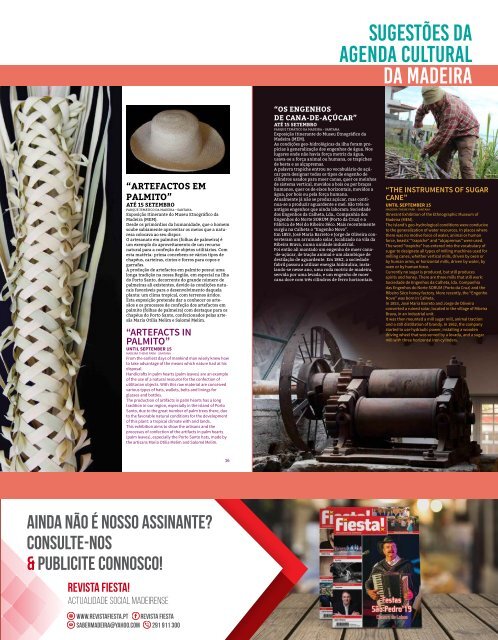You also want an ePaper? Increase the reach of your titles
YUMPU automatically turns print PDFs into web optimized ePapers that Google loves.
SUGESTÕES DA<br />
AGENDA CULTURAL<br />
DA MADEIRA<br />
“aRTEFacTOs EM<br />
PaLMiTO”<br />
aTÉ 15 sETEMBRO<br />
PARQUE TEMÁTICO DA MADEIRA – SANTANA.<br />
Exposição Itinerante do Museu Etnográfico da<br />
Madeira (MEM).<br />
Desde os primórdios da humanidade, que o homem<br />
soube sabiamente aproveitar os meios que a natureza<br />
colocava ao seu dispor.<br />
O artesanato em palmitos (folhas de palmeira) é<br />
um exemplo do aproveitamento de um recurso<br />
natural para a confeção de objetos utilitários. Com<br />
esta matéria- prima concebem-se vários tipos de<br />
chapéus, carteiras, cintos e forros para copos e<br />
garrafas.<br />
A produção de artefactos em palmito possui uma<br />
longa tradição na nossa Região, em especial na Ilha<br />
do Porto Santo, decorrente do grande número de<br />
palmeiras ali existentes, devido às condições naturais<br />
favoráveis para o desenvolvimento daquela<br />
planta: um clima tropical, com terrenos áridos.<br />
Esta exposição pretende dar a conhecer os artesãos<br />
e os processos de confeção dos artefactos em<br />
palmito (folhas de palmeira) com destaque para os<br />
chapéus do Porto Santo, confecionados pelas artesãs<br />
Maria Otília Melim e Salomé Melim.<br />
“aRTeFacTs in<br />
PaLMiTO”<br />
UNTIl SEPTEMBER 15<br />
MADEIRA THEME PARK - SANTANA<br />
From the earliest days of mankind man wisely knew how<br />
to take advantage of the means which nature had at his<br />
disposal.<br />
Handicrafts in palm hearts (palm leaves) are an example<br />
of the use of a natural resource for the confection of<br />
utilitarian objects. With this raw material are conceived<br />
various types of hats, wallets, belts and linings for<br />
glasses and bottles.<br />
The production of artifacts in palm hearts has a long<br />
tradition in our region, especially in the island of Porto<br />
Santo, due to the great number of palm trees there, due<br />
to the favorable natural conditions for the development<br />
of this plant: a tropical climate with arid lands.<br />
This exhibition aims to show the artisans and the<br />
processes of confection of the artifacts in palm hearts<br />
(palm leaves), especially the Porto Santo hats, made by<br />
the artisans Maria Otília Melim and Salomé Melim.<br />
“Os EnGEnHOs<br />
dE cana-dE-açúcaR”<br />
aTÉ 15 sETEMBRO<br />
PARQUE TEMÁTICO DA MADEIRA – SANTANA.<br />
Exposição Itinerante do Museu Etnográfico da<br />
Madeira (MEM).<br />
As condições geo-hidrológicas da ilha foram propícias<br />
à generalização dos engenhos de água. Nos<br />
lugares onde não havia força motriz da água,<br />
usava-se a força animal ou humana, os trapiches<br />
de besta e as alçapremas.<br />
A palavra trapiche entrou no vocabulário do açúcar<br />
para designar todos os tipos de engenho de<br />
cilindros usados para moer canas, quer os moinhos<br />
de sistema vertical, movidos a bois ou por braços<br />
humanos, quer os de eixos horizontais, movidos a<br />
água, por bois ou pela força humana.<br />
Atualmente já não se produz açúcar, mas continua-se<br />
a produzir aguardente e mel. São três os<br />
antigos engenhos que ainda laboram: Sociedade<br />
dos Engenhos da Calheta, Lda., Companhia dos<br />
Engenhos do Norte SORUM (Porto da Cruz) e a<br />
Fábrica de Mel do Ribeiro Sêco. Mais recentemente<br />
surgiu na Calheta o “Engenho Novo”.<br />
Em 1853, José Maria Barreto e Jorge de Oliveira converteram<br />
um arruinado solar, localizado na vila da<br />
Ribeira Brava, numa unidade industrial.<br />
Foi então ali montado um engenho de moer cana-<br />
-de-açúcar, de tração animal e um alambique de<br />
destilação de aguardente. Em 1862, a sociedade<br />
fabril passou a utilizar energia hidráulica, instalando-se<br />
nesse ano, uma roda motriz de madeira,<br />
servida por uma levada, e um engenho de moer<br />
cana doce com três cilindros de ferro horizontais.<br />
“THe insTRuMenTs OF suGaR<br />
cane”<br />
UNTIl SEPTEMBER 15<br />
MADEIRA THEME PARK - SANTANA<br />
Itinerant Exhibition of the Ethnographic Museum of<br />
Madeira (MEM).<br />
The island’s geo-hydrological conditions were conducive<br />
to the generalization of water resources. In places where<br />
there was no motive force of water, animal or human<br />
force, beasts’ “trapiche” and “alçapremas” were used.<br />
The word “trapiche” has entered into the vocabulary of<br />
sugar to designate all types of milling machines used for<br />
milling canes, whether vertical mills, driven by oxen or<br />
by human arms, or horizontal mills, driven by water, by<br />
oxen or by human force.<br />
Currently no sugar is produced, but still produces<br />
spirits and honey. There are three mills that still work:<br />
Sociedade de Engenhos da Calheta, lda. Companhia<br />
das Engenhos do Norte SORUM (Porto da Cruz) and the<br />
Ribeiro Sêco honey factory. More recently, the “Engenho<br />
Novo” was born in Calheta.<br />
In 1853, José Maria Barreto and Jorge de Oliveira<br />
converted a ruined solar, located in the village of Ribeira<br />
Brava, in an industrial unit.<br />
It was then mounted a mill sugar mill, animal traction<br />
and a still distillation of brandy. In 1862, the company<br />
started to use hydraulic power, installing a wooden<br />
driving wheel that was served by a levada, and a sugar<br />
mill with three horizontal iron cylinders.<br />
16<br />
17<br />
ainda não é nosso assinante?<br />
consulte-nos<br />
& PUBLICITE CONNOSCO!<br />
REVISTA FIESTA!<br />
ACTUALIDADE SOCIAL MADEIRENSE<br />
www.REVISTAFIESTA.pt Revista fiesta<br />
sabermadeira@yahoo.com 291 911 300<br />
saber Setembro 2019<br />
43



![s305[online]](https://documents.yumpu.com/000/067/305/916/cf88b78777c5c0fb235e0ffeac115ada7cc84fc0/5a6d555552442b37466473362f564f352f6a316a54673d3d/56785150336d30343436786f62586473456f485356773d3d.jpg?AWSAccessKeyId=AKIAICNEWSPSEKTJ5M3Q&Expires=1714723200&Signature=R8embKdUhqHhy7a3Y9XOKon0OzQ%3D)
![s304[online]](https://documents.yumpu.com/000/067/237/233/073c91a3b96f2dfd38061f8ce5ba7e22c689053b/466d523649714850334a34794e576e68383559426c773d3d/4f49554b3553722b5353693879666a464630784330673d3d.jpg?AWSAccessKeyId=AKIAICNEWSPSEKTJ5M3Q&Expires=1714723200&Signature=EA0yPlIXrKnw4gk2cw4E5G9I9Y8%3D)
![fi205[online]](https://documents.yumpu.com/000/067/237/218/276fbf7a2b0de1dd036bfa64446cb6f358aecaee/5067364467657364775152574a706e55314639516f673d3d/55462b33564636763258377a2b6a4a613873475351773d3d.jpg?AWSAccessKeyId=AKIAICNEWSPSEKTJ5M3Q&Expires=1714723200&Signature=W2I2ujxFGH1dfz%2BnPEXZ93W9DBI%3D)
![s303[online]](https://documents.yumpu.com/000/067/168/233/21c2a54fd1b272cf548448fe57b4a8c9f83fd179/6536307a73354e6847442b4e59496652475a6c5967413d3d/794a5071444a53307a7a4d38596a515163446c5956413d3d.jpg?AWSAccessKeyId=AKIAICNEWSPSEKTJ5M3Q&Expires=1714723200&Signature=Dl4V%2FKuQITLli5fbPSDCoHUOVf8%3D)
![s302[online]](https://documents.yumpu.com/000/067/081/577/8c38f5d9250ddf39b78361de2b1e80a721d59f50/746b507356557461757945435757314b72474b7a77773d3d/43755835324573334f4b6a514e3243473975343776673d3d.jpg?AWSAccessKeyId=AKIAICNEWSPSEKTJ5M3Q&Expires=1714723200&Signature=5eBGKiTnLjv7zwBwUaTLfOB5%2Fyc%3D)
![s301[online]](https://documents.yumpu.com/000/067/016/861/5a98816f5524aa2d0e28c0aa6883aef24b8cfef9/74526a495132707379755336313767363541656946673d3d/4c48686f42314f4d34336373576359373372677252513d3d.jpg?AWSAccessKeyId=AKIAICNEWSPSEKTJ5M3Q&Expires=1714723200&Signature=g9wtOhF8Z1LrtWxpTFsY4HT55H8%3D)
![fi204[online]](https://documents.yumpu.com/000/066/978/582/f8cfca7f0edef0bca47a9a8ddc7cde86ed0c5322/485a5246674d532b676d4d4d4a697357644e5a3847513d3d/584e5857684769526a744e56637a4770414856594b773d3d.jpg?AWSAccessKeyId=AKIAICNEWSPSEKTJ5M3Q&Expires=1714723200&Signature=JdPEpSNuaPnaGpw6sYtXHPq5h%2BM%3D)
![S300[online]](https://documents.yumpu.com/000/066/862/016/0189ede2cc6b3fbe6942fe0f011c7b4760969b9f/657a53307a682b73506849544344476a4f69542b78413d3d/784d38623979336f2b494d556865487a557a32546f413d3d.jpg?AWSAccessKeyId=AKIAICNEWSPSEKTJ5M3Q&Expires=1714723200&Signature=Fvp7jJm4U1gMl5IxQ8QfXwWaewo%3D)

![s298[online]](https://documents.yumpu.com/000/066/533/043/70ef177c41d5b5e4cff360a515d27e4bdfad2673/7a76434a364c71594262545633566e446b3131674d673d3d/2f39644963534a373356374c577659706236706655773d3d.jpg?AWSAccessKeyId=AKIAICNEWSPSEKTJ5M3Q&Expires=1714723200&Signature=xG39XB%2FaPpNzjQf4hmvjBgEkPj4%3D)
![fi203[online]](https://documents.yumpu.com/000/066/435/164/e79f3f0acb4188a02daac1c15bf2b17734c12a1c/754f50345154743942696c684d49747a634c676666413d3d/7052667159432f7575573057536d3558446b636b45413d3d.jpg?AWSAccessKeyId=AKIAICNEWSPSEKTJ5M3Q&Expires=1714723200&Signature=%2BbrtC1uL2W%2B3173xYdl7uap%2BvV4%3D)
![saber297[online]](https://documents.yumpu.com/000/066/351/274/f832cf7b2bf1dbc9354fca7020724d91b8d632bd/4f67704b374f72766e763635484b77503574334f5a413d3d/504d306e6859726453395342426f58676c536b6e7a513d3d.jpg?AWSAccessKeyId=AKIAICNEWSPSEKTJ5M3Q&Expires=1714723200&Signature=ukAwjUorFLNWt5JjkanlXt0LH%2FU%3D)
![S296[online]](https://documents.yumpu.com/000/066/237/665/a6b7d9874f89820e0485251998eed42bdb5c4cb2/712f6f374c644c6f505a69503865437943702b6552673d3d/697442505a774c47364e326e78434866416a6f7645773d3d.jpg?AWSAccessKeyId=AKIAICNEWSPSEKTJ5M3Q&Expires=1714723200&Signature=f3jflpxAbr854veX2vsRKmhFF44%3D)
![fi202[online]](https://documents.yumpu.com/000/066/137/118/36667778352360e44d80c38e23e7ed5b8968ee0b/645a37505a62396f434d51746a625556507775354c513d3d/6d73357342737744696378306b64484466354a7635513d3d.jpg?AWSAccessKeyId=AKIAICNEWSPSEKTJ5M3Q&Expires=1714723200&Signature=WGFBVulNp9l5%2Fs4rLWNt%2FMybjQI%3D)
![s295[online]](https://documents.yumpu.com/000/066/088/396/56de86c369188f77db600fe7c88383f2dcfe0e82/6f554755382b76306d6b374b44554d594a6634794f773d3d/564a426e39316c692b6d7158725a75567732794375513d3d.jpg?AWSAccessKeyId=AKIAICNEWSPSEKTJ5M3Q&Expires=1714723200&Signature=SrEE9vsEzim%2FnnGfPItBZPf8mKI%3D)